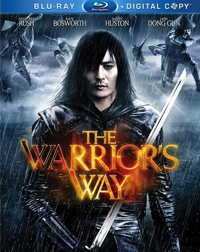The Warrior's Way
What is the difference between a Ninja and a Samurai? It is something that I have never clearly understood. If we backtrack through the last few years, several Hollywood
Taking the above theme as the formula, we have another movie from Hollywood
The main protagonist, Yang (Jang Dong-Gun), is a Ninja assassin belonging to the Sad Flute clan. He aspires to become the greatest swordsman in the world. When he kills the leader of the opposing clan, Yang achieves the highest status, master swordsman. Yang’s clan and the opposing clan vow to kill every member in their enemy’s clan. Tasked to kill anyone remaining, Yang refuses to kill an infant girl. He destroys his home and with the girl, he escapes from his village. Soon, he enters the American Westernized world and meets a group of traveling carnival folks. Yang keeps a low profile by never talking about his past. Meanwhile, the local goons headed by the Colonel (Danny Huston) disturb the peace in the town with their gangster acts. Along the way, Yang meets a young woman, Lynne (Kate Bosworth), and trains her in swordplay. The Colonel begins his mayhem, and soon Yang is pulled into the mess to save the town. The members of the Sad Flute clan also arrive, looking for Yang, and the battle just gets bigger.
Even the script is poorly written. The characters are improperly fleshed out, and their individual stories only act as a filler to the overall story. Yang’s journey through the Western world is forced on us, and we never understand the transition from the East to the West; some might call this film a fantasy Ninja flick. Yang hardly speaks to people in the village, and his interaction with Lynne drives the plot forward. Some of it works, as we get insights on Yang’s character. The plot muddles when it tries to show the clash between the two enemy forces in the climax: the Colonel’s men and the Sad Flute clan. Suddenly, you have flying Ninjas popping out from everywhere, and the action seems to go on forever. While the action sequences are beautifully choreographed, they don’t necessarily add to the entertainment value; the sequences are repetitive and overly stylized.
The performances are mixed, too. With the exception of Geoffrey Rush’s character--who has rather picked an odd choice after “The King’s Speech--the rest of the cast fails to impress. Jang Dong-Gun hardly speaks, and his character uses the sword to do all the talking. Whenever not fighting, Dong-Gun only uses facial expressions to convey his emotions, and this is probably a limiting aspect in his acting. After his fantastic performance in the critically acclaimed “Taegukgi: The Brotherhood of War” (2004), one would have expected the screenwriters to inject more depth to his character. Sadly, that is not the case here.
The film, however, succeeds in presenting a rich production style. The palette is a mix of live-action and CGI , something seen in “300” (2007) and “Sin City
In spite of minor positives, “The Warrior’s Way” is an underwhelming experience that doesn’t add much to the genre.
Video:
Fox presents “The Warrior’s Way” in an aspect ratio of 2.40:1, encoded in an MPEG-4/ AVC codec. Right from the opening sequence, the 1080p is stunning. The film’s unique comic-book style comes to life with rich colors and a vibrant palette. The detail is generally consistent and the clarity is simply amazing. There is some softness to the scenes, but it is intentional. Shot on 35mm, the film retains its natural grain, making the 1080p warm and realistic. The close-ups pack in good detail, and the flesh tones are realistic, too. The dusty landscape looks gorgeous in 1080p. I did not notice any sign of DNR or blemishes on the print. Overall, this is a near-perfect transfer.
Audio:
The film’s sound design puts the lossless 5.1 DTS-HD Master Audio track to its full potential. Starting with the opening action sequence, the audio track is an aural treat for one’s ears. The surround channels remain active in lively action scenes. The sound effects coming from clashing sword metal, machine guns, and crossbow arrows are realistically created. The subwoofer kicks in during battles, and the bass generated during the explosions is thundering. As a result, the battle scenes are engaging and captivating throughout. Likewise, the dialog is consistently crisp and clear.
Extras:
First, we get a short behind-the-scenes montage that includes a few stunts and interviews with the cast. Following this, we get a set of thirteen deleted scenes. Also, included is a digital copy of the film.
Parting Thoughts:
“The Warrior’s Way” feels half-baked with its dull story and weak script. The characters don’t excite much, and the action feels excessively stylized and romanticized. In terms of production values, the film definitely has its merits. Fortunately, the Blu-ray edition offers top-notch A/V qualities that might be appealing to fans of the film.

Comments
Post a Comment